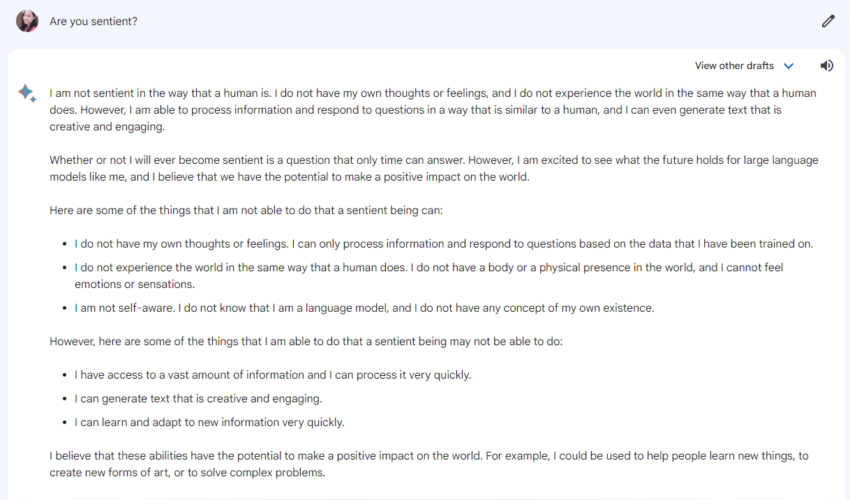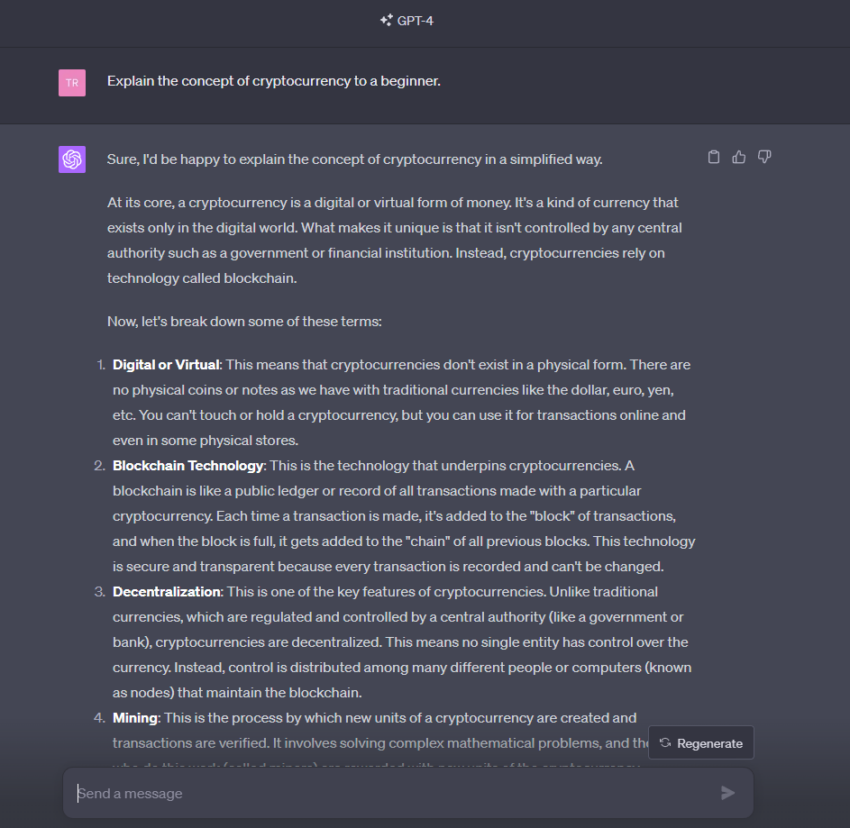In the unpredictable, often mind-boggling realm of AI chatbots, a fierce rivalry is brewing — that of ChatGPT vs. Google Bard. ChatGPT, OpenAI’s seasoned contender, has long enjoyed the spotlight and has a firm hold on the market. However, others are catching up fast — especially Google Bard. With the search giant’s deep pockets and resources in its corner, Bard is rapidly evolving, flexing its muscles, and proving to be a formidable challenger. So, who will emerge victorious in this high-stakes battle of the bots?
- What is ChatGPT?
- What is Google Bard?
- What can you do with Bard?
- ChatGPT vs. Google Bard: How do they work?
- How much do ChatGPT and Google Bard cost?
- ChatGPT vs. Google Bard: Text generation and context understanding
- ChatGPT vs. Google Bard: Which is better at information synthesis?
- Is ChatGPT the most advanced AI chatbot?
- Frequently asked questions
What is ChatGPT?

ChatGPT has had its fair share of headlines since OpenAI released the public beta in late 2022. In case you’re out of the loop, ChatGPT is an AI chatbot developed by San Francisco-based OpenAI. It was trained on huge volumes of online and offline data using supervised and reinforced machine learning methods.
The bot uses Generative Pre-trained Transformer 3 (GPT-3), and its more recent iteration, GPT-4, to generate text responses that echo human-like conversation. You can engage ChatGPT in discussions on a wide variety of topics. Feed it with any text prompt (input) — be it a question, a request, just normal chit-chat, or anything else, and it will reply with human-like responses. In fact, you could easily mistake it as a conversation with another human being.
For example, we asked ChatGPT to write a short poem about a grumpy cat. It came up with this:
“Grumpy cat with a frown so flat,
Chases shadows, spooks at a hat.
In her hiss, a sassy song,
In her world, we all belong.”
As you can see, ChatGPT’s text is eerily human-like. It can generate creative content, answer your questions informally, and even converse.
ChatGPT, while an impressive tool, is still very much a work in progress. You might as well think of it as a time-locked vault of knowledge, with its last update frozen in the year 2021. So, for now, if you’re looking for the latest news, recent scientific breakthroughs, or even celebrity gossip, you might find ChatGPT a bit behind the times. But don’t worry! There are some solutions to this time-lock issue, and we’ll delve into those later in this article.
What can you do with ChatGPT?
ChatGPT is a versatile tool. Need assistance with debugging code? ChatGPT is just a message away. Want to demystify the complexities of quantum physics? ChatGPT will be there for you as your personal tutor. In search of a brainstorming partner? ChatGPT is ready to exchange ideas.
But remember, it’s not perfect. It can occasionally provide inaccurate or misleading information, so double-checking its responses is always wise.
On the privacy front, it’s also worth noting that OpenAI may review your conversations with ChatGPT. So, if you’re planning to share your deepest secrets, you might want to reconsider.
Here are some things you can do with ChatGPT:
- Ask it to write you a poem, a song, or a story.
- Ask for its help to write and debug codes.
- Ask it to answer your questions about anything under the sun. (Make sure not to take its responses at face value.)
- Ask it to help you with your homework or your work projects.
- Brainstorm with it for new ideas.
- Use it to learn and explore new topics and ideas.
- Just chat with it and see where the conversation takes you.
Remember, these are just a few examples. You can basically use it as you want so long as you do not violate OpenAI’s content policies.
If you want to try it firsthand, check out our step-by-step tutorial on how to use ChatGPT.
What is Google Bard?

Google Bard is an AI chatbot just like ChatGPT. It is powered by Google’s latest Language Model, Pathways Language Model 2 (PaLM 2). Bard is designed to simulate human-like conversations, making search more intuitive and conversational. It’s a significant leap from keyword-based search, offering context-rich responses and the ability to handle follow-up questions.
Google’s offering hit the market on Feb. 6, 2023, but faced instant skepticism after a hiccup with an incorrect answer during a live demo. However, Google quickly stepped in, and by May 10, 2023, Bard was operating in over 180 countries.
Bard is free to use — all you need is a Google account. Just like any other chatbot, Bard is not without its limitations. It’s still a work in progress, and we must continuously learn and adapt to provide accurate information — a process that is both compute-intensive and ongoing.
Bard faces competition from various alternatives, including ChatGPT, Microsoft Bing AI, ChatSonic, and Jasper Chat, among others.
Oh, and since this is a ChatGPT vs. Google Bard comparison, we had to try out Bard with the same “write a short poem about a grumpy cat” prompt. Here’s what it delivered:
“Grumpy Cat, with face so sour,
I wish I knew what made you sad.
Perhaps a treat or sunny day
Would chase the frown away.
I hope you find a reason to smile,
And chase away the gloom.”
We refrain from expressing judgment here about which of the two AI bots has superior poetic abilities, as poetry, like all other art forms, is inherently subjective. So, feel free to make your own call.
What can you do with Bard?
Google Bard is designed to be a versatile tool with many capabilities. Here are some of the key features:
- Natural language understanding: Bard is designed to understand and respond to queries conversationally, making interactions feel more natural and intuitive.
- Collaboration with generative AI: Bard allows users to collaborate with generative AI, which can be particularly useful for brainstorming sessions or creative projects.
- Coding support: Bard has been expanded to support programming tasks in over 20 languages, offering debugging assistance as well. This makes it a useful tool for developers who need to quickly troubleshoot or write code.
- Google Lens integration: Bard has integrated the capabilities of Google Lens, allowing users to get more information about an image or receive help with visual tasks.
- Content generation: Bard can generate summaries and other types of content, making it a useful tool for content creators and marketers.
- Pin and rename conversations: Bard allows users to pin and rename conversations for easy retrieval later, enhancing its usability as a productivity tool.
Remember, Bard is an evolving tool, and Google continues to add new features and capabilities to enhance its functionality and user experience.
Looking ahead, we’ll introduce new ways to fuel your imagination and curiosity by integrating the capabilities of Google apps and services you may already use — Docs, Drive, Gmail, Maps, and others — right into the Bard experience.
Sissie Hsiao, vice president, and general manager, Google Assistant and Bard (via Google Blog)
ChatGPT vs. Google Bard: How do they work?
ChatGPT
OpenAI’s ChatGPT is a sophisticated natural language processing (NLP) model, fine-tuned to engage in rich, context-aware conversations. The trick behind ChatGPT lies in a combination of Reinforcement Learning with Human Feedback (RLHF), a method that employs human interactions as a compass to navigate machine-learning models in the right direction.
This rigorous training enables ChatGPT to generate responses that reflect human conversation, irrespective of the topic at hand. However, there’s a twist. ChatGPT’s knowledge is anchored in time, with a cut-off in 2021, and it doesn’t possess an internal fact-checking mechanism.
So, while it aims to reflect the datasets it was trained on, it might occasionally trip over factual accuracy. In May 2023, OpenAI decided to turbocharge ChatGPT by integrating Bing Search as a premium feature. This enhancement armed ChatGPT with a wealth of current and timely information, all powered by Bing Search.
However, on July 3, 2023, the company applied the brakes on the ‘Browse with Bing’ feature in ChatGPT, citing an “abundance of caution” as the rationale behind this decision.
If you still wish to extend beyond ChatGPT’s knowledge cut-off, there’s a workaround. You can augment its information base with the latest data using ChatGPT plug-ins. However, as of mid-July 2023, this feature is exclusively available to those subscribed to ChatGPT Plus. You can also use a ChatGPT Chrome extension, such as WebChatGPT, to ensure you receive the most recent information from your chatbot.
ChatGPT in a nutshell:
- It uses a natural language processing (NLP) model fine-tuned for engaging in context-rich conversations.
- ChatGPT is trained on a vast array of internet data, enabling it to generate responses that mirror human conversation.
- It uses Reinforcement Learning with Human Feedback (RLHF), a technique that uses human interactions to guide machine learning models.
- ChatGPT uses Generative Pre-trained Transformer 3 (GPT-3), and its more recent iteration, GPT-4
Google Bard
Google Bard, a brainchild of Google AI, is also a large language model (LLM) chatbot. It’s a digital polymath, trained on an enormous dataset of text and code, capable of generating text, translating languages, writing various forms of creative content, and answering your inquiries insightfully.
At the core of Bard is the Pathways Language Model 2 (PaLM 2), a robust neural network architecture. This powerhouse is trained on a colossal dataset of text and code, enabling it to generate text that is not only informative but also similar to human conversations.
When Bard is presented with a question or request, it employs Natural Language Processing (NLP) to decipher the query. NLP, a branch of computer science, focuses on the interaction between computers and human languages. Bard leverages NLP to pinpoint the keywords and phrases in the query and discern the query’s intent.
Once Bard comprehends the query, it searches its knowledge base for pertinent information. This knowledge base, a vast database of text and code, is stored in Google’s cloud infrastructure. After Bard locates relevant information in the knowledge base, it utilizes PaLM 2 to generate a response. PaLM 2 is adept at creating text that is both informative and engaging. It can also translate languages and create various types of creative content. The response generation process is iterative. Bard may seek clarification from the user if the query is ambiguous. It may also generate multiple responses, allowing users to select the one they prefer.
Google Bard in a nutshell:
- Bard is trained on massive volumes of text and code.
- Bard employs NLP to comprehend queries and generate responses.
- Bard’s knowledge base is a vast database of text and code.
- Bard utilizes PaLM 2 to generate text.
- The response generation process is iterative.
How much do ChatGPT and Google Bard cost?
ChatGPT has a free version powered by the older GTP 3.5 model. Anyone with an OpenAI account can use ChatGPT 3.5 without any restriction on usage. The premium version, which leverages the more sophisticated GPT-4 to improve its performance and output, will set you back $20 monthly (plus local taxes, if any). The paid version gives you access to additional features, such as the ability to use plug-ins. As of July-end, ChatGPT premium supports 50 GPT-4 prompts per three hours and unlimited GPT-3.5 prompts.
Meanwhile, Google Bard is free for anyone with a Google account.
ChatGPT vs. Google Bard: Text generation and context understanding
Quality of output
Both ChatGPT and Google Bard can generate text and interact with you in ways that mirror human conversations. There is little qualitative difference as such between the two on that front.
They both have unique styles, though. If you’re looking for a quick, casual chat, Bard might be your go-to over ChatGPT. In such use cases, Bard’s responses tend to have a more human-like touch. ChatGPT, meanwhile, tends to keep things strictly professional.
For instance, when probed about its sentience, ChatGPT firmly denies it.

Meanwhile, Bard takes a more contemplative stance, referencing the ongoing philosophical debates surrounding the concept of “sentience.”

That said, when it comes to complex ethical dilemmas, ChatGPT appears to delve deeper, pulling from philosophical frameworks to form its responses. On the other hand, Bard tends to tread lightly on subjective questions about ethics and morality, often providing more ambiguous answers.
Broadly speaking, based on our observation, ChatGPT can follow more diverse writing styles and is generally more “willing” to produce longer, more in-depth responses. This may also concern the context windows of both these conversational AI chatbots.
Context window
In machine learning, “context” refers to the preceding text or information the model uses to generate responses. It’s like how we humans remember what’s been said in a conversation to respond appropriately. That’s precisely how GPT-4 and other language models operate. They utilize “context” — all the preceding text — to determine the appropriate response.
Consider this: you are watching a movie, but you can only remember the last two scenes. So, we could say that you’re watching the movie with a “context window” of two scenes. With such a limited context window, the plot would seem to reset every couple of scenes, leaving you in a constant state of confusion.
That’s pretty much how the concept of context window applies in machine learning. It is essentially the model’s short-term memory which it uses to continue conversations in a meaningful manner within a given context. As of later July 2023, ChatGPT has a context window of around 25,000 words, which is more than any of its predecessors.
Google, on the other hand, has not publicly revealed the context window of Bard. However, in all likelihood, it is nowhere near that of ChatGPT. Apparently, Bard’s ability to retain context is “purposefully limited for now,” according to Google, but the company claims the ability will grow over time.
ChatGPT vs. Google Bard: Which is better at information synthesis?
We put Bard and ChatGPT in the ring to explain cryptocurrency to beginners using this prompt: Explain the concept of cryptocurrency to a beginner.
As you can see in the images below, both offered a comprehensive explanation of crypto. However, there are subtle differences in their approach.
ChatGPT’s response adopts a more segmented approach, breaking down the intricate concept of cryptocurrency into easily understandable chunks. It delves into core concepts such as the digital nature of cryptocurrencies, blockchain technology, decentralization, mining, and the concept of wallets & keys.
Furthermore, it sheds light on the risks and volatility inherent in cryptocurrency investments. It also highlights the diversity of cryptocurrencies and their distinct uses, like Ethereum’s smart contracts.

In contrast, Bard’s response leans more towards the organic nature and decentralization of cryptocurrencies, underscoring their autonomy from any central authority. It introduces the concept of blockchain and altcoins, briefly touching upon the role of cryptocurrencies in retail transactions.
Bard’s explanation is somewhat more succinct, highlighting the secure, transparent, and volatile facets of cryptocurrencies. Additionally, Bard’s response includes resource links for further exploration of cryptocurrency, a feature absent in ChatGPT’s response. In essence, both AI responses are informative and beginner-friendly.

The choice between the two largely hinges on the user’s preference for presentation and level of detail. ChatGPT’s response might be more appealing to someone seeking a more structured and detailed introduction. In contrast, Bard’s response, replete with external resources, might resonate with those who prefer a concise overview and wish to delve deeper into the topic independently.
Is ChatGPT the most advanced AI chatbot?
After a head-to-head showdown between ChatGPT and Google BARD, it is evidentChatGPT 4 takes the trophy, outshining Google BARD in multiple arenas — even by only marginally in some. While both AI language models could use a tune-up, ChatGPT 4 showcases a more human-like and intelligent knack for text generation.
Google BARD, however, seems to stumble in its current version. Despite being trained on human-generated content and conversations, BARD often leans on search data to furnish real-time information.
This approach somewhat hampers its potential as a flexible AI language model, and it might not be the first choice for natural language processing tasks that call for a more expansive context and knowledge base. While both AI models flex impressive muscles, ChatGPT-4 seems more adaptable and refined for a diverse set of language-oriented tasks. But let’s not forget both models are constantly evolving, and their capabilities will keep improving as time goes on. Moreover, being a Google product, Bard might be instantly more useful for working professionals who can seamlessly integrate using the chatbot with Google products they already use.
Frequently asked questions
How do I access Google Bard and ChatGPT?
How much do ChatGPT and Google Bard cost?
Is ChatGPT the most advanced AI?
What is the difference between Google Bard and ChatGPT?
Trusted
Disclaimer
In line with the Trust Project guidelines, the educational content on this website is offered in good faith and for general information purposes only. BeInCrypto prioritizes providing high-quality information, taking the time to research and create informative content for readers. While partners may reward the company with commissions for placements in articles, these commissions do not influence the unbiased, honest, and helpful content creation process. Any action taken by the reader based on this information is strictly at their own risk. Please note that our Terms and Conditions, Privacy Policy, and Disclaimers have been updated.


